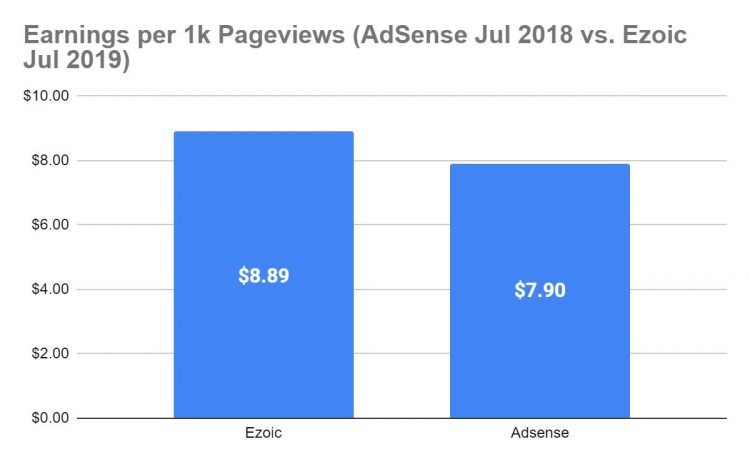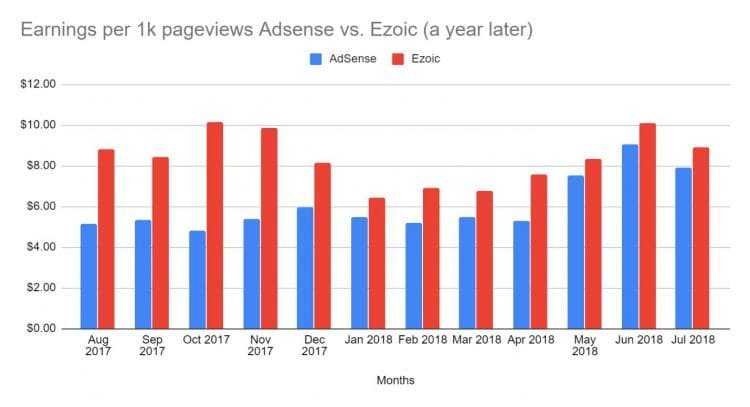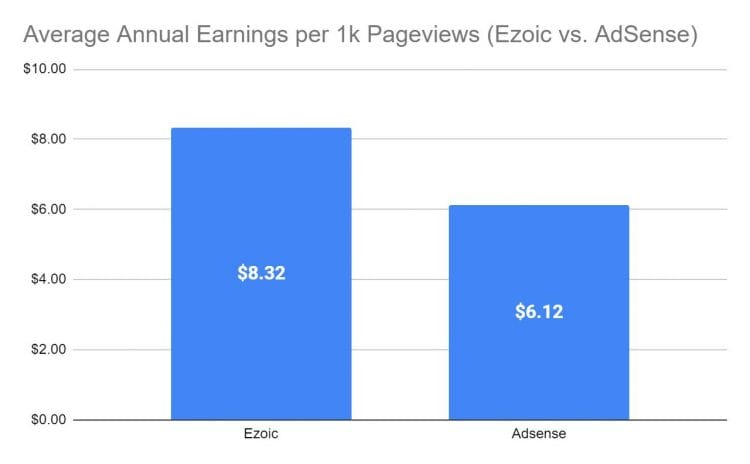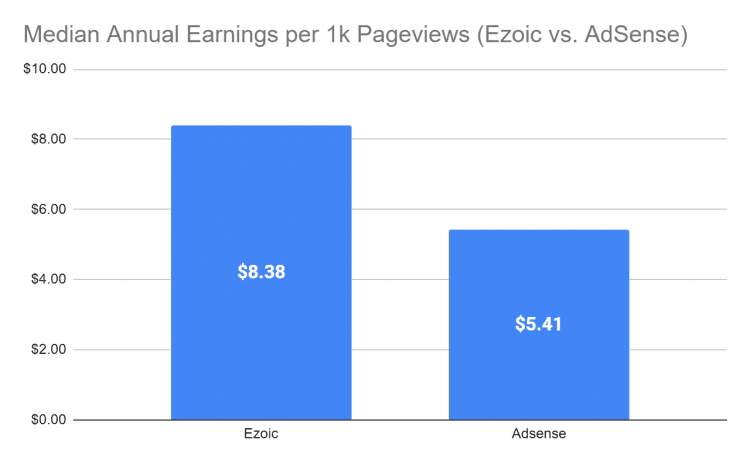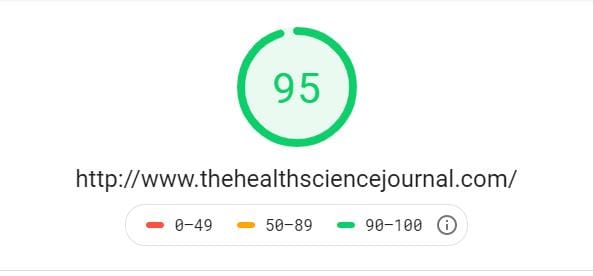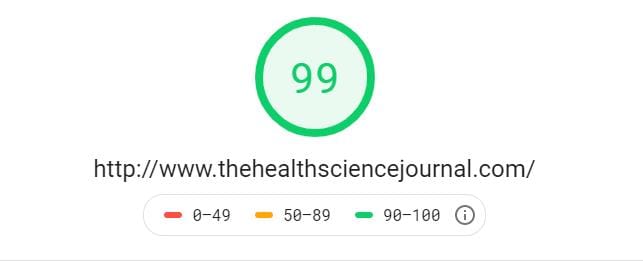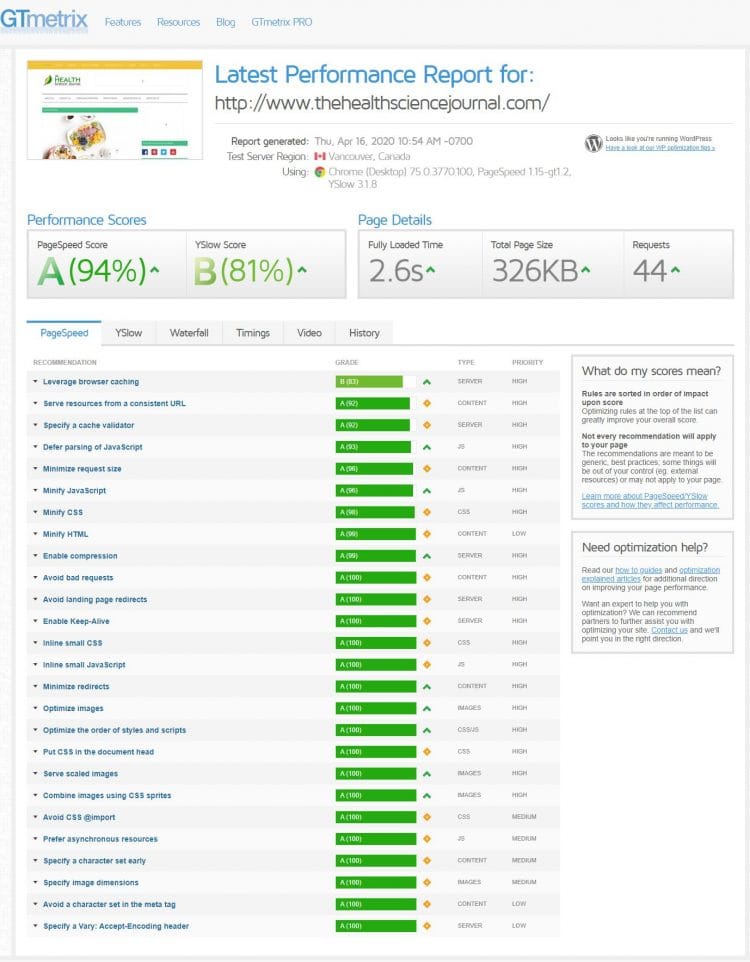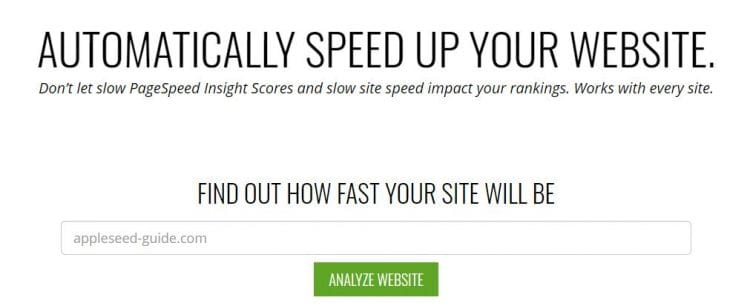After almost two years with Ezoic, I want to share with our readers what that journey has been like and in doing so, hopefully, answer if Ezoic’s services are something you might be interested in. This won’t be your typical “hey, since joining Ezoic my EPMV has increased from $5 to $8” kind of “review”. We’ll carefully examine their apps and performance, compare with AdSense and then conclude if Ezoic was the right step for our blog.
Note: I run a small health blog. We don’t do paid reviews or placements. Everything in this post is from my personal experience using Ezoic on our health blog.
What is Ezoic?
The way I see it, Ezoic essentially manages the ads on your website. Instead of you manually arranging size, type and ad placement, this is all done by Ezoic’s mechanism based on AI learning. This mechanism, called Ad Tester, will test different models and, learning from it, apply the most effective (profitable) combination of ads on your pages.
Instead of spending your time and resources monitoring ad performance, Ezoic says their Ad Tester will do that for you, much faster and to optimal efficiency and profitability.
Your ad space will have access to Google’s Ad Exchange, top header bidding partners and exclusive PMP deals. You can also link your existing ad networks, like AdSense.
Ezoic also has other interesting apps, like Site Speed and even offers free hosting solutions for their customers. We’ll talk more about that later in the article.
Ezoic’s Requirements
There are a few requirements that your site must meet in order to join Ezoic. They are:
- you must have an active AdSense account associated with your website;
- minimum of 10,000 visits per month;
- Compliance with Google’s policies;
- Site content: all content must be original, constructive and enticing;
- Your site must be written in an AdSense-supported language;
- Type of site: Ezoic works with informational and content rich sites.
Starting with Ezoic
Before we started with Ezoic, I tried to gather as much info about them as possible. I read user reviews, I checked their website and proceeded with contacting them directly to ask questions for some two weeks before my team and I decided to join them.
We joined Ezoic on the 1st of August, 2018, opening a free account. To be perfectly honest, I didn’t expect much RMP/CPM improvement from Ezoic’s Ad Tester. My page admin is an experienced IT and I already knew we were well optimized. If there was some CPC/CPM improvement, great, who can refuse better performing ads. The primary reason for joining Ezoic, however, was one of convenience. Ezoic can pay you your ad income through PayPal, no matter the country of residence.
Our AdSense account was opened from a country where I only lived temporarily (due to work) and have no residence. The AdSense revenue for this country’s accounts can only be transferred via local banks. This meant I had to actually travel back to that country to pick up the check at the end of the month, or ask the bank there to wire my funds to my current bank, which incurred unnecessary expenses and fees.
Google says to change the payment country of your AdSense account, you have to close your active account and open a new account from your new country of residence. That was not something I was comfortable with, especially knowing the problems people face when opening new AdSense accounts for domains that already had an account connected with them.
By using Ezoic, I am now able to receive my ad revenue through PayPal, and pick it up in whatever country I want.
The second major reason for joining Ezoic was freeing my site admin from daily ad management. By doing this I hoped to be able to use him much more in content-creating activities and projects.
So, to sum it up, our reasons for joining Ezoic were:
- Getting ad revenue payments through PayPal;
- Freeing up my site admin to help with content creation; and
- Getting better CPM/EPMV rates, as advertised by Ezoic.
These were the expectations with which we joined Ezoic. The first one is granted by simply joining Ezoic, while #2 would depend on #3 – the ad performance of Ezoic Ad Tester.
There are two choices when joining Ezoic. You can join for free or do a paid subscription. If you join for free, Ezoic will add a narrow bar of ad space at the bottom of your website, where it can display ads and retain the ad revenue. The earnings from these ads go to Ezoic, not to you.
Paid subscription removes these additional ads and offers some additional services (like advanced ad management, Intelligent Caching, premium CDN, etc.).
We joined Ezoic with a free account.
Measuring Ad Performance Challenges
I spent a lot of time analyzing the ad performance differences between AdSense and Ezoic. In order to make an objective comparison, I had two main challenges:
- When you transfer to Ezoic you stop being served by AdSense directly, meaning that your ad statistics don’t show on the AdSense app;
- After transferring you can follow ad statistics on the Ezoic app, however, they use different metrics from AdSense to measure ad performance.
The first challenge means that I will have to compare different time periods for Ezoic and AdSense. Because of the seasonal nature of the ads, I decided that it’s best to compare the same month, just from different years.
For example, I start the analysis by comparing Ezoic ad performance for July 2019 with AdSense ad performance from July 2018. Every month from 2019 and 2020 for Ezoic is compared with the same exact month for AdSense, just one year prior, from 2018 to 2019.
For the second challenge, since AdSense uses CPC and page RPM and Ezoic uses ePMV to measure ad performance, and since both provide pageviews and earnings stats, we decided to go with earnings per 1000 pageviews as a metric to measure the performance of both and easily compare them.
Since our traffic quantity is seasonal and can vary, while its quality is more or less the same, we think that comparing earnings per 1000 pageviews is an accurate and simple to understand method.
Note: the majority of our traffic comes from the USA and our niche is health and fitness.
AdSense vs Ezoic
Time to do the math.
Since we started with Ezoic on the 1st of August 2018, the last month of ad data I have from AdSense is from July 2018. This is why I want to start this analysis by comparing July 2018 AdSense data with July 2019 Ezoic data.
From Chart 1 (July: AdSense vs Ezoic) above you can see the earnings per 1k pageviews for each day of the month of July (2018 for AdSense and 2019 for Ezoic).
From this chart, we can see that while AdSense has a few jumps in earnings, on average Ezoic performs better. Furthermore, it is also more stable, with less drops and rises on daily basis.
How much better does Ezoic perform?
We can see that Ezoic brings an increase in average monthly earnings, from $7.90 per thousand pageviews to $8.89, which is an increase of 12.5 percent. A modest increase then? Yes, but a single month doesn’t tell the whole story.
If we analyze a full year of AdSense earnings vs full year of Ezoic earnings (a year later), comparing month to month, we get a much better picture.
Chart 3 above shows exactly that, a month vs month analysis starting from August 2017 to July 2018 for AdSense and from August 2018 to July 2019 for Ezoic. Same months compared, only the year differs. This type of annual comparison should eliminate seasonal changes during the year.
The same annual analysis in Chart 4 shows a few things even more clearly:
- Ezoic brings better earnings, regardless of seasonal fluctuations. There are few months where AdSense is close, but Ezoic wins every month. If we join the previous daily analysis with this monthly analysis, a trend is clear: while AdSense can post better earnings on an occasional individual day, at the end of the month Ezoic always performs better.
- While Ezoic is more stable on a day-to-day basis (less earnings fluctuation from day to day), it does show more seasonal variation month-to-month than AdSense. If we don’t consider the last three months (May to July 2018/19) AdSense earnings on a monthly basis are pretty stable, all between $5 and $6 per 1k pageviews. On the other hand, Ezoic’s monthly rates fluctuate a bit more throughout the year, from $6 to more than $10.
What does this all mean for your annual ad earnings?
At the end of the day (or the year), summa summarum, Ezoic offers better ad performance. The yearly average of earnings per 1k pageviews (during the first year of using Ezoic) for my blog went from $6.12 to $8.32, which is an increase of 34.41 percent.
To put that into perspective, if we had a 100k monthly pageviews on average during the year, that year would have brought us $7,344 in ad earnings at AdSense, or $9,984 at Ezoic.
If my blog had 500k monthly pageviews on average during the year, we would have earned $36,720 from AdSense, or $49,920 from Ezoic that year. Yes, the stats say we would have lost $13,200 during the year if continued with AdSense instead of switching to Ezoic.
If you are more interested in the earning differences on quarterly (rather than yearly) basis, a median instead of an average of annual earnings might be useful:
It seems that the rise in the last three months (May to July 2018/19) hurts AdSense more in the median calculation, than the drop (January to March 2018/19) does Ezoic. The median chart shows Ezoic outperforming AdSense to a bigger degree than the average chart: 54.9 percent increase in earnings.
This might seem contradictory to my previous statement that AdSense seems more seasonally stable during the year than Ezoic. However, I’ll stand by my original statement. In these types of analysis, I always look with skepticism at anomalies in the trends. If we remove the three months with significant increase from AdSense and the three months with significant drop from Ezoic, it becomes clear that AdSense is less susceptible to month-to-month earnings fluctuations.
One the other hand, I also stand by my assessment that Ezoic has a more stable (less variation) day-to-day earning rate, with AdSense being prone to making significant jumps and drops a few days each month.
My Thoughts on AdSense vs Ezoic Ad Performance
Even though I only showed the day-to-day analysis for a single month, the same trend is more or less present throughout every month I analyzed from August 2017 to July 2019.
I will also consider updating this story by the end of 2020, to see if a second year at Ezoic changes something from the analysis. Until now, April 2020, the signs show the trend will be similar this year, too.
Another thing I want to mention is the performance of Ezoic Ad Tester during the very first month after switching to Ezoic.
The earnings per 1k pageviews for August 2018, the first month with Ezoic, was $8.81. If I compare this with August 2017, our AdSense rate was just $5.14. That is more than 70 percent improvement.
However, since we usually had good rates and better CPC during the summer with AdSense, I didn’t really notice that major increase in earnings at the beginning.
You see, if we compare July 2018, the last month with AdSense and August 2018, the first month with Ezoic, the difference in rates is not huge: $7.90 with AdSense and $8.81 per 1k pageviews with Ezoic. That is only an 11.5 percent increase, month to month. That is not a difference you can easily notice. It probably took 2-3 months for me to realize the increase in earnings that we got with Ezoic.
If you are considering joining Ezoic because of better ad rates, here are a few advices:
- Join between August and September. Ezoic’s rates seem to follow seasonal trends. It’s probably a result of the quarter-to-quarter business nature of the advertisers and the increased ad budget before and around the holiday seasons. Our rates at Ezoic are the highest from October to just until the holiday season in December. January to March would be the worst time to join Ezoic (see Chart 4 above). Still better than AdSense, though.
- The difference between AdSense and Ezoic ad earnings will also depend on how well you’ve optimized AdSense on your blog. If you are very experienced in optimizing ads and follow their performance on a daily basis, the improvement that Ezoic will bring in earnings might be less than the 34.41 percent increase we experienced. I am sure that there will be an increase, though, as Ad Tester gives you access to Google’s Ad Exchange and top header bidding partners. I don’t have ad optimization experience myself, however, my site admin is an experienced IT and I am told we were well optimized with AdSense before we joined Ezoic, so make of that what you will.
- Ezoic’s Ad Tester might take some time to show results. Ad Tester is based on experimenting and learning, so it might take a couple of days to gather all the necessary data to optimize for your blog/page.
- If you don’t experience the expected increase in ePMV rates with Ezoic on your first month with them, check the same month during the previous year. First, I would compare not only the rates between this month and last month, but also the same month during the previous year (because of the seasonal nature of ad earnings). Our first month with Ezoic we had only an 11.5 percent increase in eMPV on a month-to-month basis, however compared with the same month the previous year, the increase was actually more than 70 percent.
- If you have already joined Ezoic, but want to make sure you are earning more than from AdSense, you can take half your visitors to Ezoic and the other half to AdSense placed ads, or simply disable Ezoic altogether (pic above). If you are not convinced that you are getting better ad rates through Ezoic, there is an option that can split your traffic equally between Ezoic and Adsense ads. This allows for a quick comparison between the two. Or, you can simply turn off Ezoic’s Ad Tester and use solely AdSense again. You can change between the two for a week, a month or longer and compare their performance directly.
Free Hosting Services
In January 2020, with our hosting plan at SiteGround expiring, we learned of a free WordPress hosting option provided by Ezoic. We tried it and decided to keep it. Honestly, it’s not as fast as the SiteGround plan we had, but together with Site Speed (more about that below) the difference wasn’t that great and, hey, it’s free.
If I have to compare this free hosting with some other hosting solutions we’ve used in the past, I’d say it ranks somewhere along the $20-30 per month options at HostGator or GoDaddy. Furthermore, HostGator and GoDaddy have monthly visitors and/or bandwidth limitations, while Ezoic doesn’t impose any limits.
If you are running a WordPress blog, the free hosting might be something to think about. Especially in combination with their Site Speed app.
Site Speed App
Site Speed Accelerator does just that – speeds up your site. And it’s not just code optimization – they employ fast caching on their servers. Unfortunately, unlike their WP hosting, Site Speed is not free.
These are the current (as of April, 2020) Site Speed prices:
- Less than 50k pageviews per month – $19 per month;
- 50k – 100k pageviews per month – $27 per month;
- 100k – 250k pageviews per month – $40 per month;
- 250k – 500k pageviews per month – $55 per month;
- 500k – 1 mil pageviews per month – $69 per month;
- 1 mil – 2 mil pageviews per month – $97 per month;
- 2 mil – 5 mil pageviews per month – $179 per month;
- 5 mil – 10 mil pageviews per month – $310 per month;
- 10 mil – 20 mil pageviews per month – $489 per month;
- 20 mil – 50 mil pageviews per month – $699 per month.
Yes, not exactly cheap, but here is why you should care: Site Speed works!
We have used many plugins and optimizations to increase the speed of our blog, but I have yet to see something that works as well and is as easy as Site Speed.
Since we started using Ezoic’s free WP hosting, we used our hosting budget to subscribe to Site Speed. The speed of our site rose from 52 to 95 for mobile, and from 70 to 99 for desktop, according to Google’s PageSpeed Insights:
Here is the GTmetrix test for our blog:
We went from 7-12 seconds of page loading time to under 3 seconds. This is an amazing result and it will obviously affect your search rankings with Google.
What I like about the free hosting solution and Site Speed app is that you can use the former to pay for the latter. Since we joined Ezoic’s free WP hosting we just used our hosting budget to pay for Site Speed.
What you end up with is better site speed, improved rankings and organic traffic and even some leftover cash in our case (since we used to pay more for hosting than we now pay for Site Speed).
But even if you don’t use their hosting or ad services, I would still check Site Speed. It’s a standalone app and you have a free 7-day trial. Even better, you have the option to test how Site Speed would work on your blog/page for free, without even installing the app.
As you’ve probably caught on, I like Site Speed. I especially like it for small and medium size WP blogs, which can use it together with the free hosting option and basically get it for free.
Ezoic Ad Tester vs AdSense Auto Ads
We were curious about AdSense’s Auto Ads and tried it for a week during November 2019.
We ran Auto Ads for seven days, Monday to Sunday, and then compared the results with previous week’s stats with Ezoic Ads. Auto Ads was set-up to show an equivalent quantity of ads to Ezoic.
The results: Ezoic generated 18.9 percent higher earnings per 1k visitors than Auto Ads. Having access to Google’s Ad Exchange, top header bidding partners and exclusive PMP deals again shows the value for Ezoic. And this is with a free Ezoic account (not Ezoic Premium).
I also have to admit that I like Auto Ads. It’s very simple to set-up, similar to Ezoic, and helps bloggers do more content creation and less ad management (as it should be). The only flaw is the lower earnings than Ezoic.
Ezoic’s Help with Pinterest
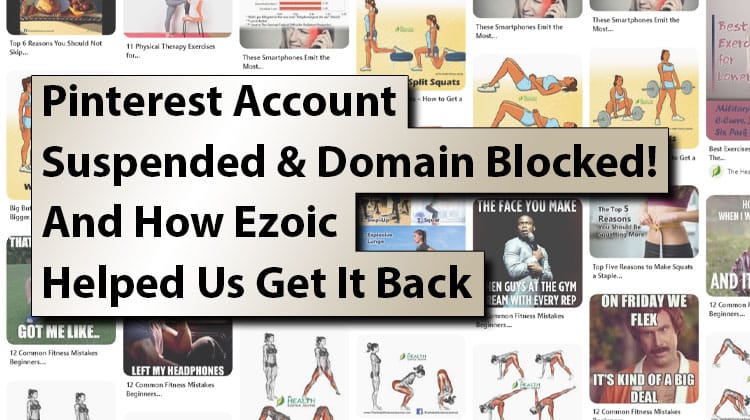
I wrote a full article about this a few months ago, but I also want to briefly mention it here as it gives insight into Ezoic’s customer service.
In January, 2020, soon after changing our hosting platform, our domain was blocked by Pinterest. A few days after contacting Pinterest support, our whole Pinterest account was suspended on suspicion of spam.
Obviously, we knew there must be some kind of mistake. We are not a spammy website and have worked painstakingly for four years to build our 80k Pinterest followers.
A week of writing to Pinterest support proved futile and soon we had to face the fact that we might have lost our account, followers, regular traffic and fours years of work on original pins.
At this point I was desperate; my blog was in danger and I decided to write Ezoic and ask for their help. From my first email they were nothing but supportive and we quickly brainstormed together how to proceed.
Morgan from Ezoic, who led our efforts to have our account restored, started contacting Pinterest and working with them on why our domain was blocked in the first place. A week later, we had our domain unblocked and our account fully reactivated, thanks to Morgan and Ezoic.
Here you can read the full story on how our Pinterest account got suspended and how Ezoic helped us get it back.
Conclusion
PROs
- You can join Ezoic for free;
- You have the option to get paid through PayPal regardless of your country of residence;
- ePMV/Earnings improved by 34.41 percent for our blog;
- Free WordPress hosting solution;
- Site Speed App can drastically improve the speed of your site and search rankings;
- Customer support.
CONs
- Additional ads at the bottom of the page;
- Slow loading ads on occasion, that don’t seem to affect overall site load speed;
- Ezoic Premium is expensive (but possibly worth it).
It’s been almost two years since we started with Ezoic and after running extensive analysis I feel confident enough to say that joining Ezoic was the right decision for our blog.
Had we not joined them, I am sure we would have generated less revenue, produced less content, and could quite possibly be without our Pinterest account.
I stated the reasons why we joined Ezoic at the start of this article: have our ad revenue paid to us through PayPal, automatic ad management and better ePMV/ad earnings. All those were met and we also got free hosting and a much faster website.
Obviously, there are different types of blogs and different monetization methods and Ezoic won’t be the right call for all. I have tried to provide as much info as possible in this article to help you, our readers, make an informed decision if Ezoic might fit your own blogging needs.
From my experience in the last two years, if you are solely running AdSense on your content-based blog, you might be losing money (and time) by not running Ezoic instead.
Bottom Line
Verdict: Ezoic increased our earnings by 34.41 percent, improved our site speed and search rankings and helped us with Pinterest when we thought our account lost. It’s also free to join, you can switch it off at any time, or even directly compare it with AdSense to make sure you are getting a better deal. All of this makes it an easy recommendation for us and a valid alternative to AdSense.
P.S. If you would like us to do additional analysis or answer any questions, please don’t hesitate to tell us in the comments below. Also, if you need more info or have some questions, please feel free to contact us directly at: thsj.journal@gmail.com or through our contact form. I’ll be more than glad to help.
Furthermore, if I can’t help you, I can connect you directly with Morgan (our contact at Ezoic, who’s been a great help for us on more than one occasion) for a chat outside their official channels ;)



